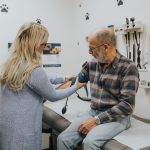What is a blood-borne viral infection (BBVI)?
A blood-borne viral infection (BBVI) is a virus that is present in the blood and can be transmitted from one person to another through blood-to-blood contact. Common examples include:
- Hepatitis B (HBV)
- Hepatitis C (HCV)
- Human Immunodeficiency Virus (HIV)
Responsibilities of regulated members
If you are a regulated member who performs exposure-prone procedures, it is your responsibility to:
- Know your viral status.
- Undergo regular testing.
- Self-report to CPSA if you test positive for a BBVI.
These requirements help protect both patients and healthcare providers, and ensure that care is delivered safely and ethically.
What is an exposure-prone procedure (EPP)?
An exposure-prone procedure (EPP) is an invasive medical procedure where a healthcare provider’s hands may be in contact with sharp instruments or tissue inside a patient’s wound or body cavity. These types of procedures carry a higher risk for the transmission of blood-borne viral infections (BBVIs).
Examples of EPPs include:
- Surgical procedures (any type).
- Emergency, non-elective procedures performed in high-risk settings (such as emergency rooms).
- Situations where there is a realistic risk of being bitten by a patient, such as during certain psychiatric or pediatric care interactions.
Alberta Expert Review Panel
CPSA’s Health & Practice Conditions Monitoring (HPCM) team works with physicians diagnosed with a BBVI to coordinate appropriate monitoring and ensure the continued delivery of safe patient care.
Physicians with a BBVI who perform EPPs are referred to the Alberta Expert Review Panel (ERP). The ERP:
- Provides anonymous, case-by-case reviews.
- Offers recommendations for safe clinical practice and appropriate monitoring.
- Supports both healthcare workers and regulators in managing BBVIs in the workplace.
- Is administered by CPSA on behalf of all regulated health professions in Alberta.
Questions about BBVIs, EPPs or the Expert Review Panel?
Contact Health & Practice Conditions Monitoring.



















